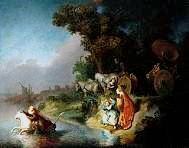 |
 |
 |
 |
Grades/Level: Middle School (6–8)
Subjects: Visual Arts, English–Language Arts
Time Required: 2–Part Lesson
One to three class periods
Author: J. Paul Getty Museum Education Staff
Permissions: 
The lesson plan and downloadable materials on this page are licensed under a Creative Commons Attribution 4.0 International License. |
 |
|
 |
 |
 |
 |
 |
 |
 |
Lesson Overview |
 |
Students will observe the painting The Abduction of Europa by Rembrandt Harmensz. Van Rijn. They will then form groups to create a tableau vivant (living picture) inspired by Rembrandt's The Abduction of Europa. Students will choose a character in the painting and create a scenario about what they think happened and what the character said before and after the scene. Each group will then collaborate and perform their tableau vivant for the class. |
 |
 |
 |
 |
 |
Learning Objectives |
 |
Students will be able to:
• observe the figures and setting in the painting The Abduction of Europa by Rembrandt Harmensz. Van Rijn.
• choose a character in the painting and write the thoughts and verbal expressions of the character before and after the scene.
• perform a tableau vivant inspired by the painting The Abduction of Europa.
|
 |
 |
 |
 |
 |
 |
 |
 |
 |
Materials |
 |
• Reproduction of The Abduction of Europa by Rembrandt Harmensz. van Rijn
• Background Information and Questions for Teaching about The Abduction of Europa
• Student Handout: "Dramatizing Europa: Before"
• Student Handout: "Dramatizing Europa: After"
• Pencils and/or pens
• Fabric and/or clothing from home for costumes
• Flashlights
• Props (optional)
• Paper (8 1/2" x 11"; ruled) (optional) |
 |
 |
 |
 |
 |
|
|
 |
 |
 |
 |
 |
Lesson Steps |
 |
1. Show students the reproduction of The Abduction of Europa by Rembrandt Harmensz. van Rijn. Review the related "Background Information" before using relevant "Questions for Teaching" to direct student observations of the artwork as needed.
2. Tell students to be prepared for the activity by bringing clothing from home to serve as costumes for the tableau vivant. Also provide colorful fabrics for students.
3. Explain to students that stories can be told in many different ways. Tell them they will create a tableau vivant (a living picture), inspired by Rembrandt's The Abduction of Europa.
4. Form students into groups of seven. Tell students in each group to choose one character in the painting to play, including a narrator who will introduce the scene. (All seven roles should be chosen in each group.) Have groups discuss what they think is happening in the scene and what each character is thinking or saying.
5. Pass out the student handout "Dramatizing Europa: Before" with the pencils and/or pens.
6. Instruct students to look closely at their character's expression and body language in the painting, and to write a sentence describing what they think their character was saying or feeling right before this scene. Have them write this sentence in the appropriate space on the handout.
7. Pass out the student handout "Dramatizing Europa: After."
8. Tell students to re-examine Rembrandt's The Abduction of Europa, looking closely at their character's expression and body language. Have them write a sentence describing what they think their character would say or feel right after this scene. Tell them to write this in the appropriate space on the handout.
9. Now have students put it all together! Ask them to prepare and dress in their costumes. Tell student groups to pose and perform their character's lines, based on what happened before and after the scene depicted in Rembrandt's The Abduction of Europa. A student narrator should introduce each scene and may use a flashlight to highlight different characters or areas of the tableau.
|
 |
 |
 |
| The Abduction of Europa, Rembrandt Harmensz. van Rijn, 1632 |
 |
|
 |
 |
 |
 |
 |
 |
 |
Assessment |
 |
Students will be assessed on their
• observations of the figures and setting in the painting The Abduction of Europa by Rembrandt Harmensz. Van Rijn.
• written thoughts and verbal expressions of the characters in the painting before and after the scene.
• participation in a presentation of a tableau vivant inspired by the painting The Abduction of Europa.
|
 |
 |
 |
 |
 |
Extensions |
 |
Have students videotape or take photographs of their classmates' tableaux vivants. |
 |
 |
 |
 |
 |
 |
 |
 |
 |
Standards Addressed |
 |
Common Core Standards for English Language Arts
Grades 6–8
WRITING
Production and Distribution of Writing
4. Produce clear and coherent writing in which the development, organization, and style are appropriate to task, purpose, and audience.
SPEAKING AND LISTENING
Comprehension and Collaboration
1. Prepare for and participate effectively in a range of conversations and collaborations with diverse partners, building on others' ideas and expressing their own clearly and persuasively.
2. Integrate and evaluate information presented in diverse media and formats, including visually, quantitatively, and orally.
|
 |

|
 |
 |
 |



